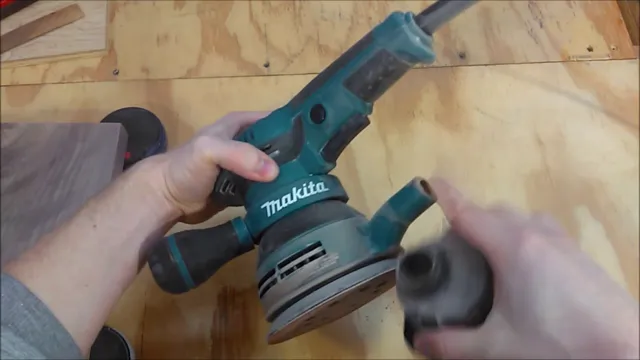How to Change Pad on Makita Orbital Sander: A Step-by-Step Guide

If you’re a DIY enthusiast or professional carpenter, you know that maintaining your tools is an essential aspect of achieving quality results. One of the tools that require regular maintenance is the Makita Orbital Sander. While this tool helps you sand surfaces with less effort, its pads wear out over time, affecting the quality of the sanding.
In this blog, we’ll cover the steps on how to change pad on Makita Orbital Sander to ensure you keep your equipment in good working condition. So, sit tight, and let’s dive right into it!
Safety Precautions
If you need to change the pad on your Makita orbital sander, there are a few important safety precautions you should take to ensure the process goes smoothly and accident-free. First and foremost, make sure the sander is unplugged before you begin. You don’t want to accidentally turn it on while you’re working on it! Next, wear protective gear such as safety goggles and gloves to prevent any debris or dust from getting into your eyes or skin.
Once you’ve taken these safety precautions, you can begin changing the pad on your Makita orbital sander by first removing the old pad with a wrench or pliers, and then installing the new pad by aligning it with the holes on the sander and securing it with the bolt. By taking these simple safety precautions, you can easily and safely change the pad on your Makita orbital sander and get back to your project in no time.
Unplug the Sander and Remove the Pad
Before starting any maintenance task on your sander, the first and foremost thing you should always remember is to unplug it from the power source. It may sound like a no-brainer but accidents happen, and it’s better to be safe than sorry. Aside from unplugging the tool, it’s also essential to remove the pad before doing any repairs or replacements.
Removing the pad will give you access to the sander disk, allowing you to inspect and clean it properly. Always make sure to wear protective gear, such as gloves and safety goggles, when dealing with power tools. Your safety should always be your top priority.
By taking these extra precautions, you can prevent accidents and ensure that your sander remains in good working condition. Remember, safety first!

Clean the Sanding Disc and Replace the Pad
When it comes to using a sander, it’s important to take the necessary precautions to ensure your safety. One of the most crucial steps is to clean the sanding disc and replace the pad regularly. This can help to prevent debris and dust from building up on the disc, which can cause it to become less effective and potentially dangerous during use.
Additionally, replacing the pad can help to ensure a secure and even grip on the surface being sanded, which can also help to improve safety and prevent accidents. So, before you begin any sanding project, take a few moments to clean the disc and check the pad to ensure optimal safety and performance. Remember, taking these measures can help to keep you safe and make your sanding tasks more efficient and effective.
Choosing the Right Pad
When it comes to changing the pad on your Makita orbital sander, it’s important to choose the right pad for the job. There are a variety of pads available, each with their own unique features and benefits. For example, a foam pad is great for smoothing out rough surfaces, while a hard pad is ideal for removing paint or varnish.
It’s also important to consider the size of the pad – larger pads are better for covering large surface areas, while smaller pads are perfect for getting into tight spaces. When changing your pad, make sure to follow the manufacturer’s instructions carefully and ensure that it is securely attached before use. With the right pad and proper technique, your Makita orbital sander will help you achieve a smooth, polished finish on any project.
Selecting the Right Size and Grit
When it comes to polishing, selecting the right pad is crucial. The size and grit of the pad will determine the level of correction and clarity you achieve. Grit is chosen based on how much material you need to remove, with lower numbers removing more and higher numbers removing less.
Small pads are ideal for spot corrections and hard-to-reach areas, while larger pads cover more surface area and are efficient for larger surfaces. During the selection process, consider the product you are using and the task at hand. A larger pad may require more product, while a smaller pad may take longer.
Using the wrong pad can lead to unevenness and even damage to the surface, so take your time and choose wisely. In the end, the right pad will make all the difference in the quality of your results.
Understanding the Types of Pads Available
Choosing the right menstrual pad can make all the difference in your comfort and peace of mind during your period. There are several types of pads available, each with its own unique features and benefits. For those who experience heavy flow, maxi pads may be the best option, as they provide extra absorbency and protection.
If you prefer a more eco-friendly option, consider reusable cloth pads, which can be washed and reused for months. For those who prefer a thinner, more discreet option, panty liners or ultra-thin pads may be the way to go. When choosing a pad, it’s important to consider your flow, your personal preferences, and any sensitivities or allergies you may have.
By taking the time to choose the right pad, you can help ensure a more comfortable and stress-free period experience.
Replacing the Pad with the New One
When it comes to replacing the pad on your equipment, it’s important to choose the right one to ensure optimal performance. One of the first things to consider is the type of material the pad is made from. For example, foam pads are great for polishing, while microfiber pads are better suited for cleaning.
You’ll also want to think about the level of abrasiveness needed for the job. A pad with high abrasiveness may be too harsh for delicate surfaces, while a low abrasiveness pad may not remove tough stains. Additionally, consider the size and shape of the pad to ensure it fits properly and covers the necessary surface area.
By taking the time to choose the right pad, you’ll be able to achieve the best results and extend the life of your equipment.
Testing the Sander After Pad Replacement
If you’re wondering how to change the pad on your Makita orbital sander, don’t worry, it’s a relatively simple process. Once you have the new pad in hand, the first step is to remove the old pad. This is typically done by loosening the screw that holds the pad in place, and then taking off the pad.
Make sure to clean the pad’s mounting surface before attaching the new pad. The new pad should slide into place easily, and then you can tighten the screw to secure it tightly. Once the new pad is in place, it’s a good idea to test it out.
Turn on your sander and run it on a piece of scrap wood to ensure that the pad is properly installed and working effectively. With a new pad, your sander should provide a smoother sanding experience, helping you get better results in your woodworking projects.
Plug the Sander and Test it Out
After replacing the pad on your sander, it’s important to plug it in and test it out before starting your next woodworking project. This will ensure that the new pad has been installed correctly and that the sander is operating at peak performance. Start by turning on the sander and running it without any wood or sandpaper for a few seconds to make sure everything is aligned properly.
Then, add some sandpaper and test it on a scrap piece of wood to check for any vibrations or uneven sanding. If everything looks good, you’re ready to start your next project! Remember to always wear protective gear and follow safety instructions when using power tools. Keep in mind that regular maintenance like pad replacement can extend the life of your sander and save you money in the long run.
Adjusting Speed and Pressure
After replacing the pad of your sander, it’s important to test the speed and pressure to ensure the new pad is working properly. Testing the sander can help you adjust the settings before starting your project. It’s recommended to start with a lower speed and minimal pressure and gradually increase them until you achieve the desired result.
Also, double-check the alignment of the pad to the machine to avoid uneven results or damage to the surface you’re working on. It’s important to consider that different materials require different sanding speeds and pressures, so it’s crucial to know what you’re working with before testing your sander. A good practice is to do a test pass on a small, inconspicuous area before proceeding with the whole project.
Remember, taking the extra time to test your sander can significantly improve the final result and prevent mistakes.
Conclusion
And there you have it, folks! Changing the pad on your Makita orbital sander is as easy as pie. With just a few simple steps, you can have a fresh pad ready to tackle any sanding project with ease. So go ahead and give it a try, because nothing says power tool mastery like being able to swap out a sanding pad like a pro!”
FAQs
What tools are needed to change the pad on a Makita orbital sander?
To change the pad on a Makita orbital sander, you will need a screwdriver, pliers, and a new replacement pad.
How often should I change the pad on my Makita orbital sander?
It is recommended to change the pad on your Makita orbital sander every 6-12 months, depending on usage frequency and wear and tear.
Can I use a different brand of sanding pad on my Makita orbital sander?
While it is possible to use a different brand of sanding pad on your Makita orbital sander, it is recommended to stick with the same brand to ensure proper fit and function.
How do I remove the old pad from my Makita orbital sander?
To remove the old pad from your Makita orbital sander, use a screwdriver and pliers to unscrew and remove the mounting screws and then gently pull the pad off the sander.
How do I attach the new pad onto my Makita orbital sander?
To attach the new pad onto your Makita orbital sander, align the holes on the pad with the holes on the sander base and secure the mounting screws using a screwdriver and pliers.
What is the best type of sanding pad to use for my Makita orbital sander?
The best type of sanding pad to use for your Makita orbital sander depends on the type of material you will be sanding. Consult with the sanding pad manufacturer or sales representative for recommendations.
Can I clean and reuse my old sanding pad on my Makita orbital sander?
It is not recommended to clean and reuse old sanding pads on your Makita orbital sander as they may have become worn and lose their abrasive properties, compromising the quality of your sanding job.







